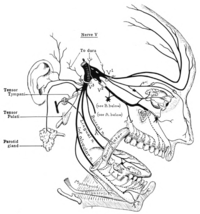
Photo from wikipedia
Abstract Classic trigeminal neuralgia (CTN) is a chronic neuropathic pain state characterized by intense, piercing spasms of the orofacial region, and may be attributable to abnormal pain processing in the… Click to show full abstract
Abstract Classic trigeminal neuralgia (CTN) is a chronic neuropathic pain state characterized by intense, piercing spasms of the orofacial region, and may be attributable to abnormal pain processing in the central nervous system. Our study investigated neuronal alterations using voxel-based morphometry (VBM), diffuse tensor imaging (DTI), and resting-state functional connectivity in 38 patients with CTN and 38 matched healthy controls. For voxel-based morphometry analyses, patients with CTN displayed gray matter volume (GMV) reductions in the anterior-cingulate cortex (ACC) and mid-cingulate cortex, insula, secondary somatosensory cortex (S2), primary motor cortex (M1), premotor area, and several regions in the temporal lobe. For DTI analysis, patients compared with controls had increased mean diffusivity (MD) and decreased fractional anisotropy (FA) in the corpus callosum and the bilateral corona radiata, and increased mean diffusivity with no fractional anisotropy changes across the bilateral superior longitudinal fasciculus, the internal and external capsule, the thalamus and brainstem. Additionally, patients with CTN had enhanced functional connectivity between the right insula/S2 and ACC, medial prefrontal cortex, posterior cingulate cortex, and bilateral dorsolateral prefrontal cortex. Furthermore, gray matter volume of left inferior temporal gyrus negatively correlated with current pain intensity and disease duration in patients, and connectivity of the right insula/S2-ACC was negatively correlated with pain intensity, depression, and anxiety ratings. This study provides multiple lines of evidence supporting aberrant structural and functional patterns that are observed in patients with CTN, which may help us better understand the pathophysiology of CTN and facilitate the development of new therapies for this disease.
Journal Title: PAIN
Year Published: 2017
Link to full text (if available)
Share on Social Media: Sign Up to like & get
recommendations!